Ethanol Production in Semi-Arid Lands
Ethanol is made by distilling sugars found in vegetable matter. More than 1/3 of the land area on earth is considered semi-arid or arid. Thus, we address the changes in conventional ethanol production required to make ethanol in countries with these conditions in sufficient quantities to fuel their transportation systems.
The key changes are in the Ethanol PLant Processing Needed and in the crops used for feedstock. We will discuss feedstocks first and then engineering processing changes. The key for both areas is to conserve water. In both case continued progress in technology and science will play an important role in the success of Dry Lands Fuel Ethanol Production.
Success in the efforts to economically produce ethanol in Dry Lands will have many important implications. Among them the decoupling of food stocks from ethanol production, and the raising the standard of living of many poorer peoples of the earth.
1. Dry land Crops for Ethanol Production
1.1. Sorghums
There are generally 3 types of sorghum: Grain Sorghum, Sweet Sorghum and Biomass Sorghum. Generally, grain sorghum is bred to produce the largest grain heads and yields, and the shortest stalks. Sweet Sorghum has be bred to produce the most sugar in it stalks, and has about 1/2 the grain, and energy sorghum has been bred to produce the most biomass (typically with no grain).
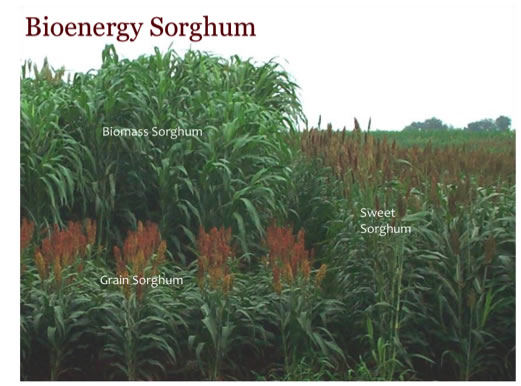
All sorghums require less water than corn.

1.2. Grain Sorghum or Milo
Grain sorghum or ???? can grow in semi-arid regions. The yield per acre is slightly less than corn, but of course, it has not undergone the intensive crop improvement that corn has.
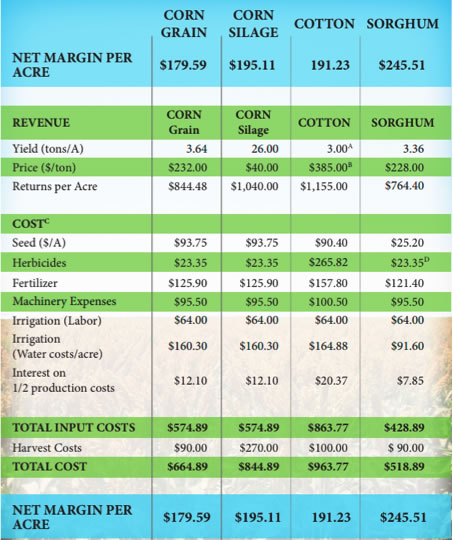
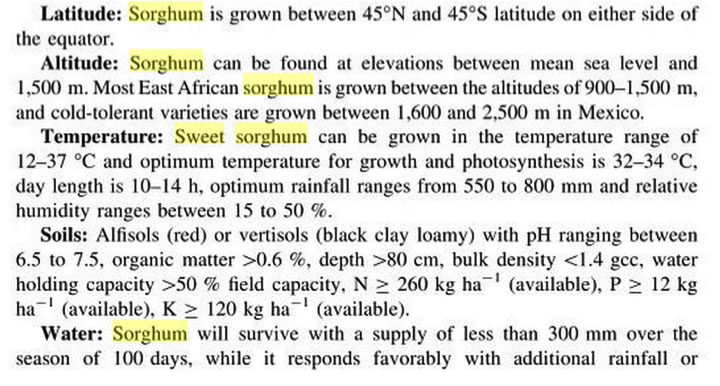
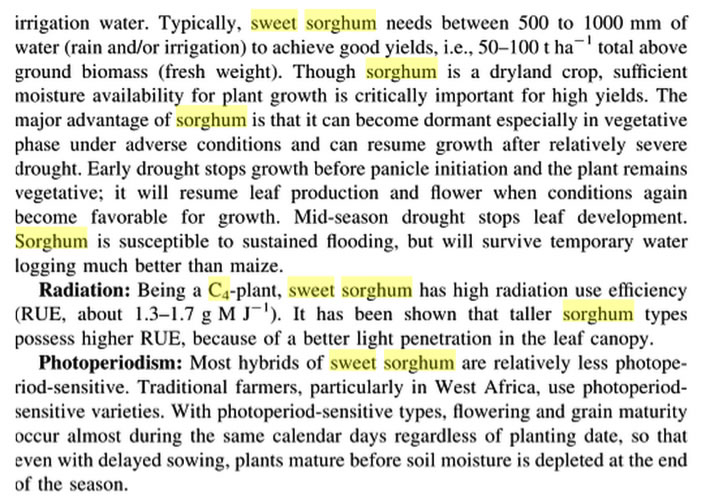
Based on the numbers from USDA, a sorghum ethanol plant uses 96.3% of the thermal process energy of a corn ethanol plant (3.7% less), and 99.3% of the electrical energy (0.7% less).
1.3. Sweet Sorghum
The variety of sorghum called sweet sorghum has a number of advantages for ethanol production over sorghum. In particular, the sugar in its stalks is directly fermentable. Sweet Sorghum is drought resistant (using about 1/2 the water of corn, it is cheaper to plant (costing about 1/3 that of corn), it grows fast (120-135 days).

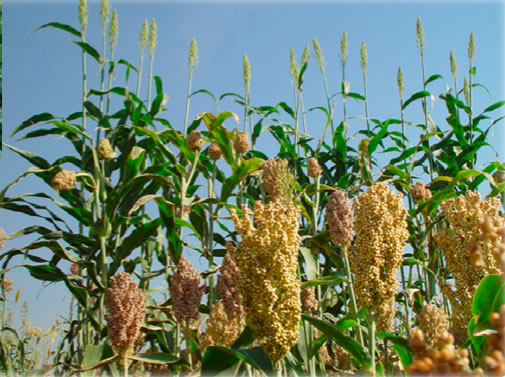
A comparison of Sweet Sorghum with sugarcane and sugar beets, the two most often preferred feedstocks(if water is available) is:


1.4. Biomass Sorghum
The delineation between sweet and biomass sorghum is getting gray. Biomass sorghum is bred to be strongly photosensitive, not to flower, to have long canopy duration, enhanced drought tolerance and higher yields, with minimal starch and lower sugar. We are looking for the maximum biomass achievable per acre.
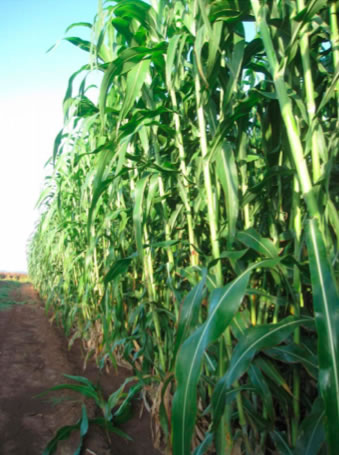
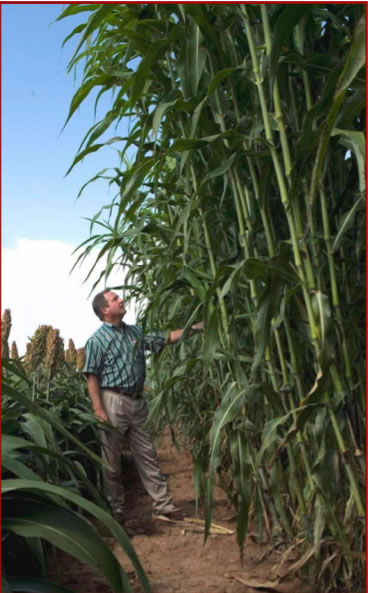
2. Production of Ethanol with Water Conservation
Water is a key component to the ethanol producing process, Todd Potas of U.S. Water Services said, noting that some of the properties that make it so are its abundance, it holds heat, it is low cost, it has great propensity for holding chemistry and most importantly for dry grind ethanol, it allows for fermentation. You can remove the heat with evaporated cooling and it also allows for separation through things like distillation,” he said.The graph below illustrates that the cost of ethanol production essentially does not depend on the cost of water.
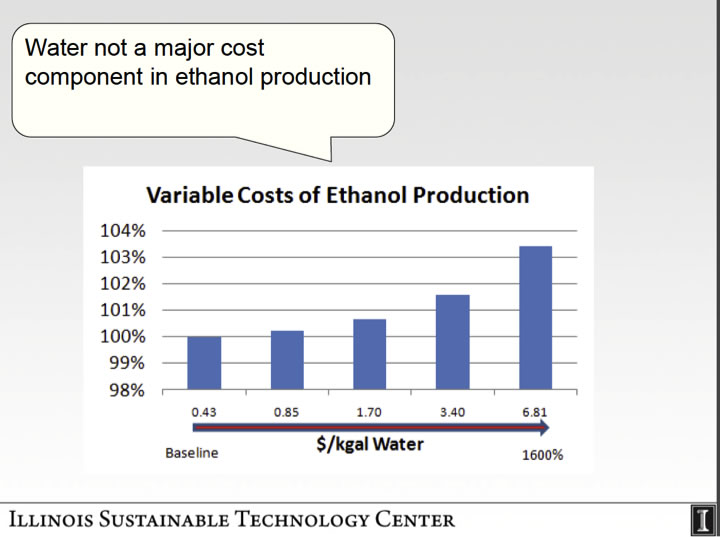
“The biggest and most difficult issue with water is that you must maintain sustainability with it.” Potas continued. “It’s very critical to appreciate the resource and understand the resource and what you have available to work with. Discharge regulations are constantly changing and it’s a very dynamic environment.”
In an effort to avoid issues such as contamination and green house gas emissions, Potas said the ethanol industry is trying to take advantage of the natural hydrologic cycle (evaporation, condensation, precipitation and so forth) when using water for processing. “Wherever we take the water from, greatly affects the quality of that water,” he said. “Lakes, streams anything on the surface is typically the softest water available. As you go into the ground for well water, that water becomes hard and picks up contaminants.”
2.1. The Amount of Water used per Gallon of Ethanol from Corn
In terms of gallons of water per gallon of ethanol produced, there’s a lot of information available today, Potas noted, adding that 1.5 gallons of water per 1 gallon of ethanol produced is the goal number. “I think it is possible,” he said. “In the older facilities – anything pre-2000 – they were doing about 4.5 or 4.6 gallons of water per gallon of ethanol produced. Any of the new plants built after 2000, were doing about 3.4 gallons. All with roughly the same water quality.” As of 2008, Potas said that number dropped to 2.85 gallons with the University of Chicago reporting 2.7 gallons in 2009. “The progression has been very rapid as the industry has matured,” Potas said.
To put the water use levels into perspective, Potas said that when compared to some other industries, this is far less than what it takes to create even a can of vegetables, which takes 9 gallons of water per can.
So where are we today? The benchmark, Potas said is really 2.9 to 3.4 gallons of water per gallon of ethanol produced
“The optimized facilities that are employing some of the readily available commercial strategies are achieving 2.4 to 3.0.” he said, noting that some of the facilities that have embraced “pretty much all of the strategies that are available with integrated zero liquid discharge,” are achieving 1.7 to 2.1. “In some cases those are the same facility – 2.1 in the summer and 1.7 in the winter when cooling is optimum and efficient,” he said. “So the predication (of 1.5 gallons of water per gallon of ethanol produced) is proving to be pretty accurate.”
Potas explained that water balance is the strategy necessary to achieve this water use in the ethanol industry. A variety of water sources are available he said, namely noting the water available from the wells and municipalities, gray water from municipal waste water treatment plants, surface lake options (which are typically very good quality soft water) and storm water. This water is treated to various qualities for the facility with the boiler quality being the most difficult to achieve as it requires the cleanest, purest water.
For water use in the ethanol plant, the cooling tower requires 50 to 55 percent; boiler 16 to 20; treatment 14 to 18 and the processing 12 to 16. “We really need to appreciate where the majority of the water is going,” Potas explained, adding that they like the tower to be even a higher percentage. This is illustrated below:
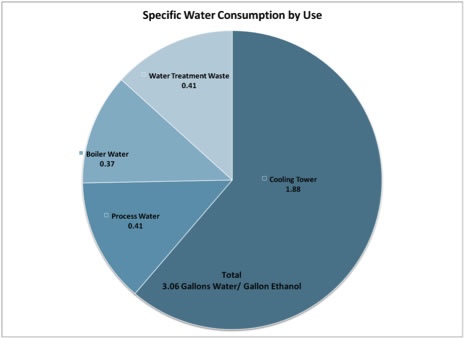
By running sludge through a gravity filter followed by a filter press, Potas said the leftovers can be used elsewhere. “A landfill is your least desirable option,” he stated. “Hopefully you can use it for farm soil conditioning or fertilization or you can use it as a nutrient in the distillers grains.
“ Reverse osmosis works as a semi permeable membrane under pressure, allowing pure water to go through the membrane and the dissolved solids are held back. The pure water becomes permeate for boilers and cooling towers. “When we look at what the payoff is for this water treatment, you can get excellent water quality,” he said.
Potas said that the best opportunity to reduce water use at a facility includes the boiler system – where 20 percent of steam can be lost at the front end of the facility. “This water increases the amount of water you need in the process, which is detrimental to your water balance,” he explained. “If you can reduce or reuse this water it can greatly save you.” Every 100,000 pounds of steam requires about 6,500 extra gallons of water, Potas noted. If a facility is using 20,000 pounds of steam an hour to sterilize the mash in the ethanol plant, that is 11 million gallons a year. Boiler bleed/blow down involves relatively clean water. “It’s hot so there is energy there. This water is often reintroduced into the process,” Potas said, adding that 60 percent of ethanol facilities do this.
It is important to minimize drift in cooling towers, Potas said. You only want evaporation leaving the water tower – not water droplets. This can also help with air emissions because there are particulates in those water droplets that a facility has to account for. “From a control standpoint, the bleed water and the water in the system are the same concentration,” Potas continued. “The tighter you can hold the control on that, the better water use you are going to have, the lower discharge you’ll have on your permit, the lower chemistry you’ll use and also the better consistency you’ll have for your system.” New water does have to be utilized, however, because at a certain level, algae, bacteria and fungi develop in the system. A storm water collection system – which typically has quite soft water – is beneficial because as it is used, the biological concerns (total dissolved solids) become less.
“It’s very effective to reuse this water in the cooling tower system. You may need to do a little filtration to take out suspended solids,” Potas stated. One final option (that does require capital investment) would be to collect the water vapor out of stack, which could represent up to 4 million gallons of water per year.
“If you can get 11 million gallons from the steam injection, 4 million from boiler bleed, 20 million in cooling tower, 10 million for storm water use and if we use the condensate from the stack that’s the savings of roughly 50 million gallons of water a year,” Potas said. “We’ve gone from 3.5 to 2.5 gallons with some relatively ready, commercially available technology to tighten up the water.”
“It’s very important to look at water balance, begin planning and continually improve. This can help ethanol be more profitable, greener and more sustainable in the future years.”
2.2. The Amount of Water Used per Gallon of Ethanol from Sugarcane
As indicated above, the b est opportunity to reduce water use at a facility includes the boiler system. Well if we start with sugar, we don't need steam created by the boiler.
2.1.1. The food vs. fuel debate
2.2 Ethanol from Sugar CaneTop
3. ZLD - Zero Liquid Discharge Technology
More coming soon.
4.
5.

